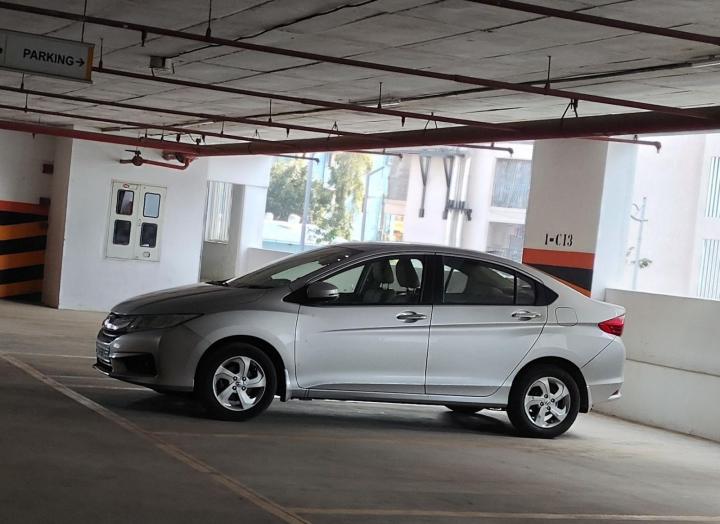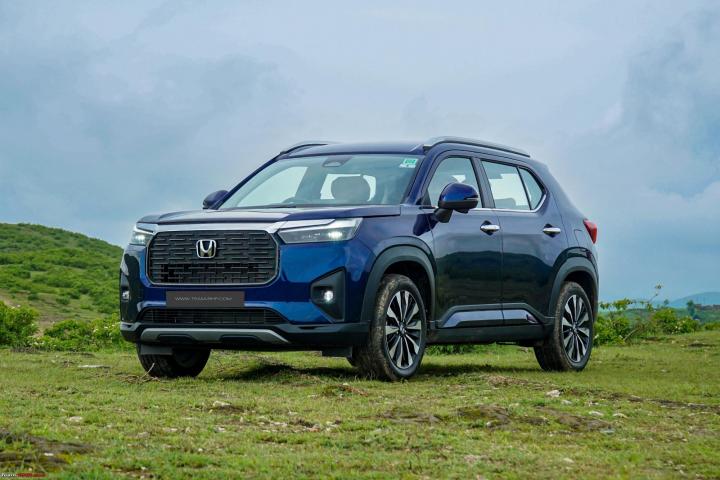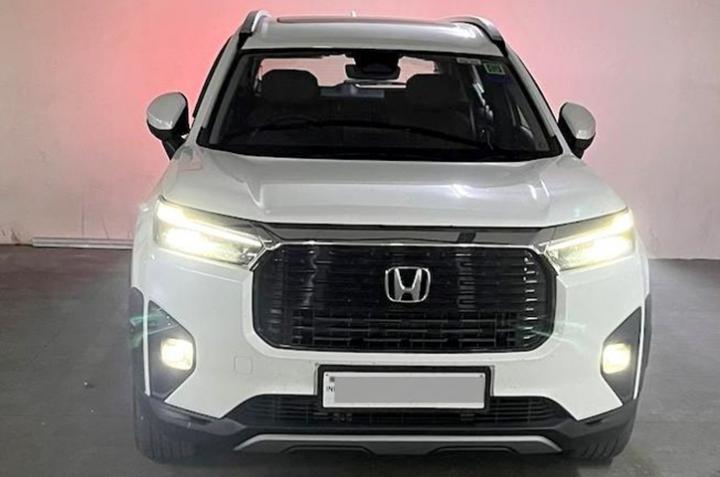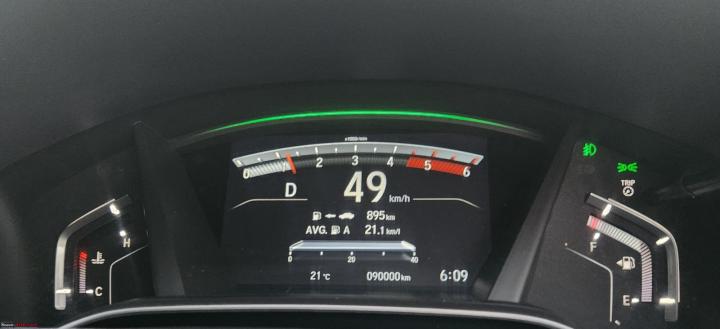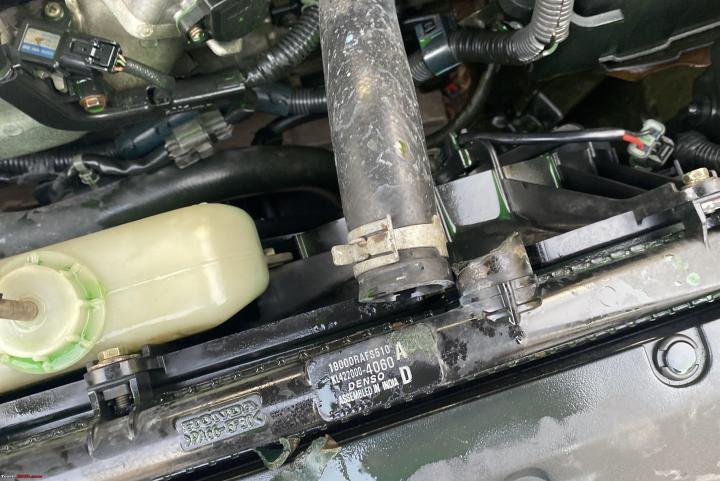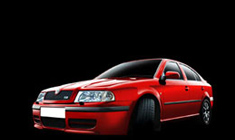News
10 years and 70,000 km with my Honda City Diesel: Ownership update
The diesel options such as Seltos and Creta Diesel look like decent alternatives in theory - but I don't see it as a wise investment to buy a Diesel car again in 2024.
BHPian vsrivatsa recently shared this with other enthusiasts.
10 years with the Honda City
I completed 10 years with the City and have been thinking about writing a post on the ownership experience and my thinking on the way forward.

The 10-year mark was completed on 03-Feb-2024 and around the same time I also completed the 70,000 kms mark on the City.

70,000 kms in 10 years seems like a lower figure as compared to my previous ownership experience but given that we went thru COVID-19 lockdowns and that the other car that we have (Ignis) has clocked 22,000+ kms with a parallel ownership cycle shows that the beater has kind of extending the life of this car.
The road to the 70,000 kms mark has been very uneven with a lot more usage in the initial years and muted usage during the COVID period. Here is a run thru of how these numbers have been clocked over the years:
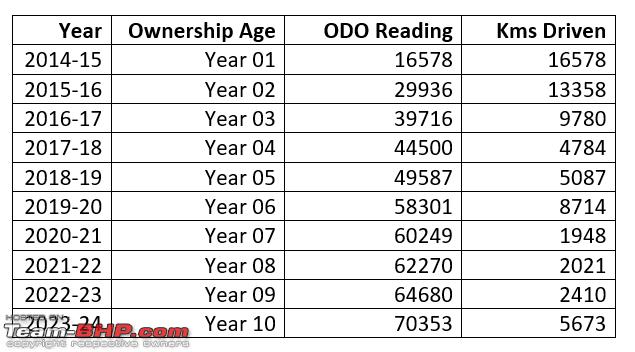
Do not see a replacement available in the market that excites me as on date to make me take the plunge toward a new car.
- The diesel options such as Seltos and Creta Diesel look like decent alternatives in theory - but I don't see it as a wise investment to buy a Diesel car again in 2024.
- Coming to the EVs - I live in an apartment and there are still debates going on about the risks of setting up an EV Charger within the premises - so EV looks impractical for the time being.
- The Hybrid route seems to be the way to move forward but there are limited choices (Grand Vitara/Hyryder) with a constrained boot.
Given this scenario, and also given that the ODO reading on my car is still on the lower side, my thinking is to continue with the ownership of the City for another 2 years and then re-visit when more hybrid options show up in the market
Check out BHPian comments for more insights and information.
News
Test drove the Elevate: Honda's reliability at a great pricing
The sunroof was small but felt adequate for the driver. The quality is infinitely better than that of the Toyota Hyryder and Maruti Grand Vitara.
BHPian SithDefender recently shared this with other enthusiasts.
For too long, folks have waited to get that sweet 1.5 from the City in a crossover form factor. The BR-V was the first, but the Mobilio had crashed the party first and Honda could not shake it off from the BR-V. Though it had its strengths, the BR-V never took off in the face of strong competition from the Creta, and later it was discontinued.
Well, the wait is over and we have the new Elevate which brings the City's engine and CVT gearbox once more. The big squarish front has its own unique identity, and you are unlikely to mistake this for any other vehicle. But somewhere it looks a little too compact and has an uncanny resemblance to the Magnite from the side profile.
Inside, the seats are comfortable, there is a nice tan theme (on the higher variants only) and it is certainly airy and full of light, unlike the swooping constricted interiors we see nowadays. But I didn't like the hard plastics throughout, plus some switches are damn cheap.
The rear seats are really nice and comfortable too, but the rear armrest slopes down at an uncomfortable angle too much. The middle seat has a rather pronounced hump. And the boot is quite large too.
The sunroof was small but felt adequate for the driver. The quality is infinitely better than the mosquito net of the Hyrider / Grand Vitara.
Both the gear shifter and handbrake could have been presented better, in keeping with the rest of the interiors. Here, I thought they looked rather ordinary.
On the go, the steering felt nice and communicative, but the engine was slightly vocal when I gave it full throttle. The suspension felt very good in controlling bad patches of road. Also, in tight gaps, the Elevate can nudge in where a bigger car would baulk. Plus, you can see the flat bonnet which is helpful.
At the end of my test drive, I was rather happy with it overall, especially given the great pricing that they have offered, and the typical Honda reliability. Yes, I wish it was a little more plush because you only have to step into the Honda City to see the differences (complete with electronic parking brake, hybrid-petrol engine, the works).
Maybe that true Honda City crossover is yet to come in a plush form later.
Check out BHPian comments for more insights and information.
- Tags:
- Indian
- Honda Elevate
- Honda
- Test Drive
News
Honda Elevate CVT replaces our 2017 Maruti S-Cross: Ownership review
Our garage, therefore, makes me happy now; this Elevate and the XUV300 TurboSport.
BHPian naadopaasaka recently shared this with other enthusiasts.
Our 2017 S-Cross Sigma with the 1.3L MJD engine has been replaced by a golden brown Honda Elevate ZX CVT in October 2023. The replacement was occasioned by the fact, primarily, that my father was getting tired of driving a manual around town on a daily basis. Our garage, therefore, makes me happy now; this Elevate and the XUV300 TurboSport (I’ve written about that here: (Mahindra XUV300 TurboSport | Ownership Review).
Here's what I think of the Elevate.
- The much-marketed lane watch camera is useful but really isn’t as useful as you think it might be. The number of use cases is too few – going close around a kerb/ footpath, changing lanes in particular circumstances, and some kinds of parallel parking. However, in the parallel parking, it doesn’t come on automatically and I haven’t actually tried using it, because the reverse camera is on mostly. In the darkness, the lane watch camera doesn’t deal very well with headlights and you see more glare than video. We picked the ZX for the 6 airbags, and this is a nice feature to have which I’d have been happy without. The reverse camera is satisfactory.
- Considering that I do most of my driving on a really torquey small-capacity turbo petrol, it took me a bit to understand that the 1.5 i-Vtec isn’t as sensitive in terms of fuel efficiency to driving style. If you don’t understand this, you tend not to get the most out of the engine, particularly with the CVT gearbox, and begin to believe that the engine simply lacks torque in the bottom and middle. If you manipulate throttle inputs just right, with a firm but not too firm beginning from a standstill, to later ease out on it as the car picks up speed, the pull will surprise you. It isn’t exciting and doesn’t give you a kick in the pants or anything, but it is more than sufficient for normal conditions. Mated to the CVT, this isn’t an enthusiast’s choice at all. The i-Vtec’s zone is said to be at the top, but I don’t see us using that often. To get about the city, it is good enough.
- Having said all that, fuel efficiency in choc-a-block Bengaluru traffic is disappointing at about 8.5-10 kmpl with the AC on and the vehicle on at all signals. But this is the worst of Bengaluru traffic.On the highway, cruising at about 100-110, I got about 15 kmpl.
- There is an abstract sense of comfort about the whole experience of the car. My father, who is the primary driver of the car, took a few months to get used to our S-Cross in 2017 and then would whine about it a bit throughout its life. The S-Cross isn’t that hard a car to get used to. In the Elevate, however, he took only 10 minutes to get used to it and praised its comfort immediately. I call this comfort abstract because it isn’t clearly attributable to any one dimension of the car: It is remarkably easy to drive and doesn’t demand too much attention, the ergonomics are great and everything is exactly where your hands expect them to be, the aesthetics of the interiors are calming, and the car just generally makes you breathe slower, which is a good thing. It isn’t quirky in any way and doesn’t require you to get used to it. It is just as it should be; it seems to adjust to you and doesn’t expect the opposite.
- The telescopic steering adjustment is available more in form than in substance. It simply doesn’t have enough range.
- As others have pointed out, the front passenger footwell doesn’t have enough flat ground before the incline for the wheel well, the front passenger seat is too low, and under-thigh support is hopelessly insufficient on both front seats. While some have complained about too much lumbar support on the front seats, as a rather thin man with a history of some problems with my spine, I am very happy with it.
- The official review describes the suspension as being soft with a firm edge, and I fully agree. It is extremely good at handling potholes and bumps but does certainly have an undertone of firmness.I think the ride-handling balance is about as good as you can expect from a car of these dimensions. There is body roll (markedly more than in the XUV300 TurboSport) but I suppose the two cars have different use cases and philosophies. I like the steering.
- The dark golden brown colour is a dust magnet but looks fantastic. It seems like it is more than one colour
- There are some disappointing things. First, there is now a light sound from some vibration in the dashboard when the vehicle is at idle. Second, cabin insulation is simply not sufficient. It is true that the engine is extremely refined. However, at higher speeds on the highway, tyre/ road noise can get annoying. Vibration and harshness are, however, sufficiently contained. Third, the rear armrest doesn’t get a flap with which to pull it out of its slot. Fourth, the child lock seems to get on rather easily. I think it gets on almost every time our car is cleaned.
- The sales experience was reasonably good. We bought our car from Dakshin Honda, Lavelle Road, Bengaluru. Our SA was Shri Farhan. We made the booking online on the first day early in July. The vehicle was ready for delivery in early/mid-October. We chose not to take delivery then because of pitru paksha/ mahalaya paksham, and ultimately took delivery in late October. Did a PDI, and Dakshin Honda was extremely cooperative with that. There were no hassles. The PDI went off very well. The car had only single-digit kilometres on the odometer then. Shri Farhan also has been extremely helpful. He has never dodged a phone call, never lost his patience with our persistent questions, seemed always available, and remained cooperative with us much after the delivery until he ensured we received our RC a few days ago. Dakshin Honda sold us a PayTM FasTag and he is now helping us out by changing to a different provider consequent to the muck PayTM finds itself in. The only time he tried something dodgy was to ask us for full payment in advance if we wanted a cancelled booking car to be allotted to us. We didn’t agree because we refused to pay in full before the PDI. To be fair to him, he didn’t persuade us any further. However, we promptly got a car allotted to us the next week. So, I wonder what was going on there. We paid ₹2 lakh before the PDI. Overall, a good experience.
- Service is, of course, through Wheels Wisdom. I have nothing but nice things to say about them. After the first service, the folks at Whitefield Honda put a sticker on the car that is rather impossible to get off. I have no idea why they did this, and it doesn’t seem appropriate at all. Wheels Wisdom told me that it was to indicate that work was complete. I don’t find that a satisfactory explanation to do that. Here’s a picture of that sticker:

- As to missing features, I really think they should have offered TPMS with the car. Honda charges I think about ₹12,500 for that as an accessory which is clearly overpriced. The dashcam is also a single-channel camera with no dual-channel option.
- I know that the Koreans are probably better at this, but I think the touch and feel of materials inside the cabin is, overall, very good. I like the brown theme and entirely appreciate all the aesthetic choices that Honda has made here. One day, I was searching for something I had dropped in the driver’s footwell and was pleasantly surprised by the lighting in the footwells – a nice touch. I also really love the design and usability of the instrument cluster.
- The ADAS features are annoying. I haven’t figured out if I can use cruise control without the adaptive bit yet. The adaptive cruise control is extremely defensive in that it leaves too large a gap between you and the car in front of you. It is also extremely aggressive in its braking and acceleration. The lane keep assist is a useful feature, but the lane departure warning system can get annoying if you want to weave through traffic on the highways (which, I suppose, you shouldn’t be doing). Collision mitigation braking is an annoyance within the city, but I would rather have it on.I now understand why people complain about the absence of that one button (as in the City e:HEV) to turn off the ADAS features.
- Visibility is outstanding, particularly on the front. Permits precise manoeuvres and is confidence-inspiring. Makes parking easy.
- Overall, it is a Honda. Nothing remarkable, nothing wrong. It is doing well. Close to 3,000 kms thus far.
Check out BHPian comments for more insights and information.
News
How I ended up buying Honda Elevate: Worthy successor to my old Jazz
Hyundai Creta and Seltos failed to impress me. Even Mahindra XUV700's advanced electronics and Scorpio N's ruggedness couldn't sway me. But the Elevate…
BHPian sibaprasadbeher recently shared this with other enthusiasts.
How I Ended Up Buying the Honda Elevate Pearl White
In the vast landscape of car choices, finding the perfect match can feel like searching for a needle in a haystack. You weigh features, performance, comfort, and reliability, hoping to strike that elusive balance that fits your lifestyle. My journey to purchasing the Honda Elevate Pearl White was a meticulous process, driven by specific needs and preferences that evolved over time.
To give you some context, I was already a proud owner of a 2013 Hyundai i20 and a 2017 Honda Jazz (V) MT, which had served me well. However, as time passed, my requirements evolved. I craved a car with more power, ok space for my family (4 of us with a 4-year-old), and above all, unwavering reliability akin to my beloved Jazz. Living in Bangalore, where road conditions can mimic the terrains of Ladakh at times, sturdy ground clearance was also a priority.
With a clear vision in mind, my quest began. The criteria were set: a dependable engine, good handling, safety features like six airbags and ESC, automatic transmission, sturdy build quality, attractive interior and exterior design, along with PRACTICAL features like tilt and telescopic steering. However, I was uninterested in extravagant features like, sunroof, electrical adjustable seats, automatic wipers, auto this auto that perforated seats. I feel these features increase the cost of ownership when they go bad.
My exploration commenced with European options, such as the Taigun and Kushaq, but their narrow build and steep prices, coupled with concerns about DSG gearboxes, quickly eliminated them from contention. I somehow felt that they were overpriced, maybe I am wrong but that was my feeling. 1.0L felt underpowered and the 1.5L TSI felt overpriced and risky for the long term.
The Korean contenders, including the Creta and Seltos, failed to impress with their interior designs and ride quality. Even the allure of the XUV 700's advanced electronics and the Scorpio N's ruggedness couldn't sway me. Somehow the XUV700 design was not to my taste and Scorpio N's riding dynamics was not to my family's liking.
Then came the Tiguan, a marvel in its own right, but its price tag exceeded my budget. The car was "spot on" but somehow I didn't have that much budget "Spot on".
It wasn't until I laid eyes on the Honda Elevate that things started to fall into place. Stepping inside, my wife and I shared a silent acknowledgement: "It feels like the Jazz." This familiarity sparked a debate: if it embodied the reliability and comfort of the Jazz, why not opt for it? We had the same feeling of Taigun and Kushaq being narrower than the Jazz and Koreans were out of contention either way.
A test drive sealed the deal, highlighting its appealing aesthetics, refined interior, commendable ride quality, and driver-friendly ergonomics. Sure, there were minor gripes, like the rear seat size and the absence of roof rails, but they were outweighed by its overall package.
Booking the Elevate Pearl White ZX CVT was a bittersweet moment, as it meant bidding farewell to my faithful Jazz, which had accompanied me on countless journeys with minimal hiccups. However, the excitement of a new adventure outweighed the nostalgia.
Taking delivery of my new car was just the beginning. Embarking on a road trip from Bhubaneswar to Bangalore, I discovered its exceptional comfort and ease of handling, even at moderate speeds. The Adaptive Cruise Control added a layer of convenience, although it required some adjustment.
As I settled into life with the Elevate, I came to realize its subtle nuances and enhanced comfort compared to the Jazz. Despite initial skepticism, it proved to be a worthy successor, offering reliability, smoothness, and ease of ownership—all within my budget.
To fellow Jazz owners considering the transition, I offer this advice: give it time. The Elevate may seem familiar at first glance, but its nuances reveal themselves over time, offering a driving experience that surpasses expectations.
In conclusion, my purchase of the Honda Elevate Pearl White was not just a transaction; it was a culmination of thoughtful consideration and a desire for a vehicle that seamlessly integrates into my life.
Some stills from the 1450kms ride


Deserved a wash after the long dusty ride

1st Service the very next day
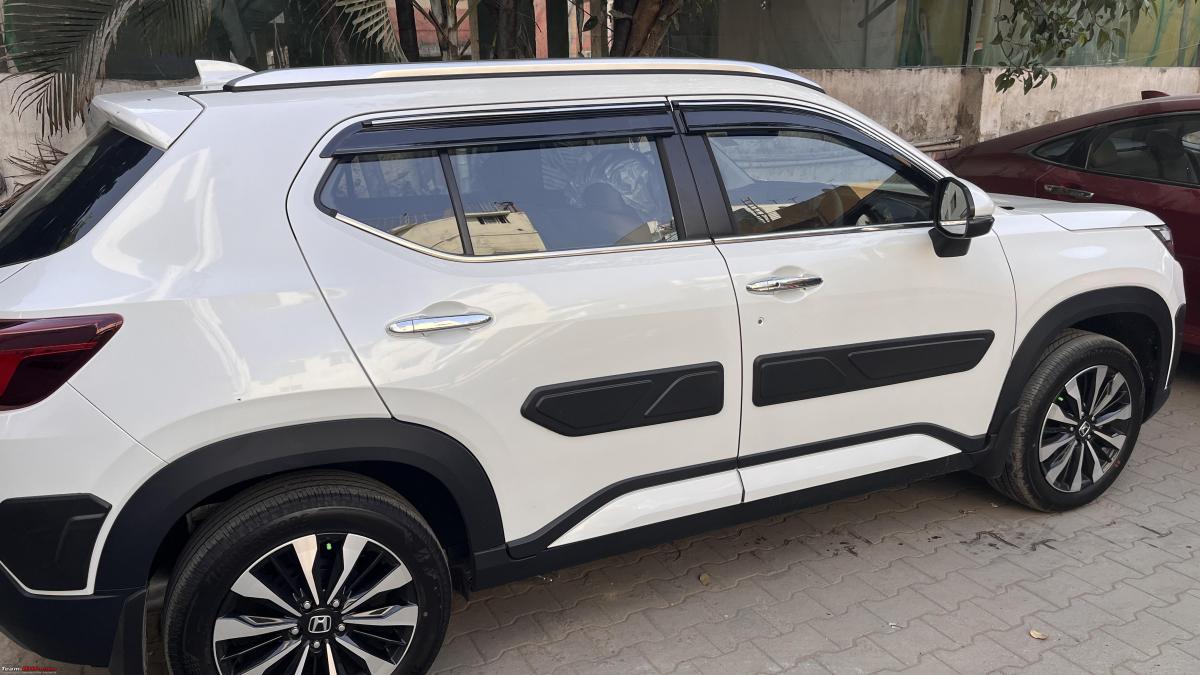
Check out BHPian comments for more insights and information.
News
Honda CR-V Diesel AT: Reliability & fuel efficiency after 90,000 km
"Big dilemma with the Fortuner and CR-V both as I just don't know what to replace them with."
BHPian rugsrags recently shared this with other enthusiasts.
So the car has clocked 90000kms. This a milestone as I usually replaced my cars earlier around 80-85k. Goes to show the improved reliability and build quality of modern machines. I can't find a fault yet in the car and it still drives and looks like new. I've still put it up on the classifieds though I doubt I will be able to change it anytime soon as I really can't find a suitable alternative to it. It came back with a service bill of 7992/- for its 90k service which is seriously very reasonable. I've still asked for the brake pads to be changed now even though the pad thickness is at 3.8mm for the front with a limit of 1.6mm and the rear at 4.2mm with a limit of 1mm. Keep in mind these are the original brake pads that came fitted with the car. The pads are on order and should be in stock soon will get them changed then.
Also, the seats were tightened over the service, and the creaking sound that was there has noticeably reduced though if you strain to hear it's still there sometimes.
The 1.6L diesel is a letdown in terms of outright performance but makes up for it in terms of frugality (I have got an average of over 17kmpl over my entire 90k kms) and the 9-speed gearbox does wonders for keeping it idling at very low rpms at cruising speeds making it a very very quiet engine on highway rides. (At 140kmph is when the 9th gear kicks in and the engine is spinning at around 1800-2000rpm! )
Attaching a picture of the trip B meter which resets every 10k kms which kind of proves my point of frugality. Over 7600kms the average has been 18kmpl!
Apart from this, I own a 2018 Fortuner which is now at 97k kms, a 2017 Honda City at 62k kms, a Bmw 3 Limo diesel at 18k kms, and a 2021 alto cng at 18k kms. Big dilemma with the Fortuner and crv both as I just don't know what to replace them with as they both drive just like the day I bought them and I can't figure out replacement vehicles

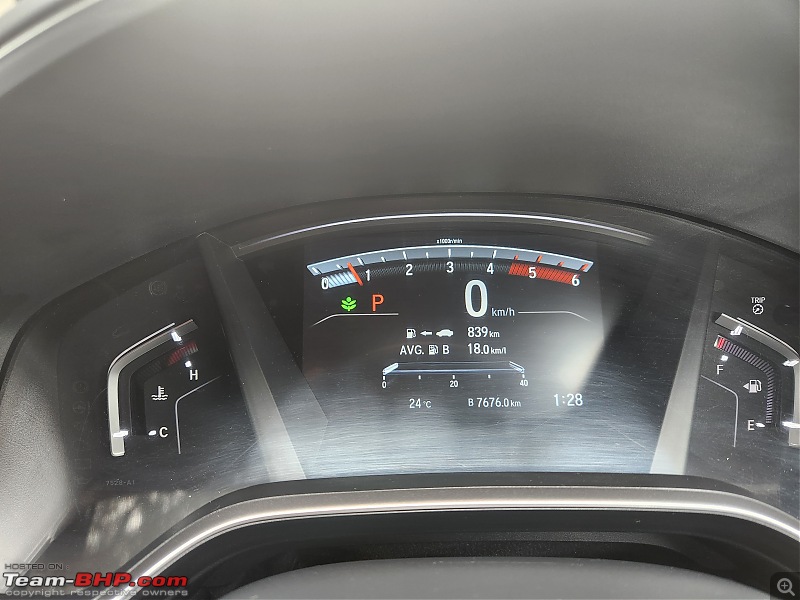
Check out BHPian comments for more insights and information.
- Tags:
- Indian
- Honda
- CR-V
- Maintenance
News
Bought an 89,000 km run diesel Amaze: Need to clarify some doubts
There are a few observations that I have made and I wanted to visit a Honda service centre for a complete check-up.
BHPian suhailcbe recently shared this with other enthusiasts.
I recently bought my first car, a Honda Amaze S (2013, Diesel, Manual, 89000 Kms). Tried my best to buy a good car and hope didn't get scammed. After driving for a few days, I'm really satisfied with my decision to buy this car. But just wanted to visit a Honda service centre and do a complete check-up. Wanted to know if they would even do a complete check-up. What should I ask for? And what should I keep in mind? Is it going to be a costly deed? (I'm kind of scared that they are gonna scam me).
There are some observations I have made that I need to get clarified by them. Like:
- Steam-like smoke from dipstick while idling
- Black smoke when the accelerator is pressed hard
- Yesterday I went for a long trip on highways and felt vibration while accelerating whenever I shifted to 5th at 50+ km/h. I don't know if I'm doing something wrong.
Any help or opinion is appreciated!
Here's what GTO had to say about the matter:
I don't recommend buying 11-year-old cars with high odometer readings as the first car. Better to buy something much newer, even if the car is a hatchback from a lower segment.
Anyway, what's done is done.
You should search through Team-BHP & find a really good, trustworthy, independent garage for your car. Once my cars are out of their extended warranty period, I usually send them to good aftermarket independents only. They work out 50% cheaper for most tasks & 75% cheaper for a few.
Here's what BHPian vattyboy had to say about the matter:
- Quite common in Diesel engines, I have seen this in my Jeep Compass and some VAG cars like Vento etc.
- BS4 diesel engines tend to emit black smoke while accelerating hard. Nothing to worry about.
- Maybe due to bad engine mounts.
Here's what BHPian Shreyans_Jain had to say about the matter:
Long-term diesel City owner here. The diesel Amaze/City need major work at and around the 80-100k km mark. Scheduled stuff as well as wear and tear related. Things like diesel filter, gear oil and coolant will require replacement in addition to the regulars. You can find details in the owner’s manual. A lot will depend on what work was done by the previous owner during the 80k km service. In case service history is not available, have it all done yourself.
Furthermore, things like suspensions, clutch and brakes may also need replacement, depending on their condition. Generally, their life is this much only. EGR will also need cleaning. Then come the tires and battery. Also, Amaze is prone to rusting. So, an underbelly anti-rust coat is not a bad idea, as the car is already 9 years old. It is a hard fact that these cars require attention and money at around this time, but will then provide reliable and trouble-free service for the next 75-100k km.
Here's what BHPian DRIV3R had to say about the matter:
Smoke from dipstick opening - it is blowby and normal only if it's very minor, constant amounts would definitely mean oil consumption in the long run.
Vibration from 5th gear and 50kmph - you are lugging the engine and hence the vibes, try upshifting at higher rpm, this shouldn't happen.
Check out BHPian comments for more insights and information.
News
Honda City ADAS pros and cons: My experience using it for 2 months
I found the Lane Departure Mitigation to be subtle and not sudden. It is one system we have come to trust.
BHPian Raptor6492 recently shared this with other enthusiasts.
It's been a little more than 2 months since we purchased a Honda City ZX CVT and I have been actively using ADAS on various occasions. Here are the problems and advantages I have come to:
Problems:
Sudden acceleration while on Adaptive Cruise
While on Adaptive Cruise, the car slows down gradually and smoothly if there is a slower car in front of you. But when the car moves or you change lanes, the car accelerates at a rate which is too fast for my liking, so much so that it made me panic a couple of times. Me and my father both found it a bit dangerous and expected a gradual acceleration. But the car simply tries to accelerate as fast as possible to the set speed and there have been occasions where we ended up disabling the cruise (by touching the brake pedal).
Emergency Braking Issue on really steep climbs
Now this has not happened once but twice. Both times the car was slowly climbing a steep stretch of road (the type where you need to get out of a parking on a lower level). I would say that in both instances the climb was really steep (Maybe more than 45 degrees). {Please don't say that the City doesn't have that kind of approach angle lol. It was a gradual climb}.
When on the steepest part, the emergency brake warning went off and the car braked to a complete stop. After talking to a couple of friends we came to the conclusion that maybe the camera could not comprehend the steep climb and it came to the decision that the car was about to crash into the road itself. I know it sounds dumb but we couldn't come to any other conclusions. I am going to tell this issue to the Service Centre on my next visit and will update what they say. Also please let me know if anyone else has had this.
No audio warning when the adaptive cruise is disabled
When the car slows below 20kmph, the adaptive cruise control turns off and you have to set it again using the controls. But I don't remember hearing a beep once it's gone off automatically. There might be a visual warning but you can't always be looking into the instrument cluster to notice it.
Overtaking on single-lane roads
If you try overtaking someone on single-lane roads, you need to use the blinkers while you get out of the lane. But after the overtake when you try getting back into your lane, the lane departure will again send warning beeps and the steering vibrates. You must use the blinker even when getting back in your lane. Now this is not a problem but it takes getting used to, hence putting it up here.
Advantages:
Works in rain
I had seen several people saying that the Honda ADAS only has a camera and no radar and hence it might not work well in rain and fog. Now I have not used it in fog, but it worked perfectly well in moderate rain for me.
Perfect lane keep assist
The lane keep assist (above 72kmph) works perfectly fine as long as there are proper markings on the road. Also, I found the lane departure mitigation to be subtle and not sudden. It is one system we have come to trust.
Here's what BHPian Kevinrevvz had to say about the matter:
I own a Facelift City Hybrid ZX and I'd like to add a few more points:
Problems:
Lane Keep Assist trigger speed too high
The LKA only activates at 72Kmph and gets deactivated once it comes down to 65Kmph as opposed to most brands like Hyundai and Kia where it works above 30Kmph and in some brands like MG and Mahindra it even works from 0Kmph. This reduces the usability drastically.
Adaptive Cruise with Low Speed Follow distance too high (e:HEV exclusive)
The Hybrid variants offer a Stop & Go feature for the ACC where it works from a standstill as opposed to above 30Kmph on iVTEC models. This feature is used as the Traffic Jam Assist in most brands. However, even the minimum distance maintained when following a car in traffic is more than one car length whereas radar based systems in other brands have a significantly closer follow distance. This renders the feature useless in our traffic conditions where everyone tries to cut into the gap.
Advantages:
Best calibration of Autonomous Emergency Braking
The AEB of Honda is the most well calibrated of any mainstream brand's ADAS I've experienced. It doesn't panic brake even in our complicated driving conditions with people cutting in and out frequently. It just warns when you're too close or too fast behind someone and takes action only when it's absolutely necessary. One of the few cars in our market where AEB can always be left on.
Warning chimes
Honda has one of the least intrusive warning chimes for LKA's "Apply Steering", Lane Departure Prevention and forward collision warning as opposed to brands like BYD where the car screams at you at full volume for any minor inconvenience on the road.
Here's what BHPian dhanushs had to say about the matter:
With so much tech being accessible to everyday vehicles and not extremely expensive premium cars like it used it, it's good to see enthusiasts get their hands on it and get into explaining in detail what they find good and bad. I'm sure it will help OEMs to calibrate the tech to make it better.
It might be old school, but, I for one will not trust driving aids completely.
ALWAYS keep in mind, they are just aids. You are the driver.
Here's what BHPian vattyboy had to say about the matter:
I was taking the drive of Honda Elevate ZX Cvt with ADAS. I was driving at around 80 kmph on the right lane on 4 lane highway. At the road crossing suddenly an Auto came out of nowhere and joined the highway. My first instinct at that time was to change lanes to the left to avoid a collision but ADAS interrupted, so I had to brake very hard and by the grace of god, the collision didn't happen.
I think for Indian Roads, ADAS is not useful. In future, if my car has ADAS then I will only use Adaptive cruise control rest I will turn it off. I don't like its Artificial feel.
Check out BHPian comments for more insights and information.
- Tags:
- Indian
- Honda City
- ADAS
- Honda
- Safety
- Car ownership
News
Few Honda Elevate issues that I observed in 25 days and 1000 km
I have compared a few things with my friend's 2023 Kia Seltos facelift and my family's 2016 Tata Tiago.
BHPian amandal1810 recently shared this with other enthusiasts.
Just got the first servicing done. Clocked 1000 km in about 25 days. Did a road trip to Chikkamagalur (from Bangalore). There are many posts here that list down the pros of this car. Let me list down some cons. Note that I will be comparing a few things with my friend's Kia Seltos (facelift) in which I have spent some time, and a few things with the family Tata Tiago (2016, XZ).
- A 360-degree camera is required in this car. At least front parking sensors should have been given. The bonnet visibility is great for driving on open roads, but the same becomes a major con when trying to park in tight spaces. I really wish that a 360-degree camera and front parking sensors were available as official accessories in the near future.
- The infotainment system feels aftermarket (it's from Alpine). Don't get me wrong - it is very responsive and has great visibility even in direct sunlight. However, it's not integrated well with the car. Example: the ADAS and other driver-related settings can only be modified from the driver information interface and not the infotainment system. This is in comparison to Kia's implementation where the settings can be accessed in both.
- Wireless Android Auto has disconnected for me three times so far. This is a known issue. The only way to reconnect was to stop the car and restart the entire car. I did not find a way to restart just the infotainment unit while the car is still running. Or am I missing something?
- The windshield washer spray range is not sufficient at all and is quite disappointing. I am comparing this to our Tata Tiago. Is this the case for others as well? Or is it just my unit?
- There is no play/pause button - neither on the steering wheel nor on the infotainment screen. Why?! Our 2016 Tata Tiago has it! There are empty button slots on the steering wheel on the right side so it could have been easily given. Note: double-clicking the power button on the infotainment screen behaves as mute/unmute.
- The Honda Connect app is very basic. It's miles behind Kia's app. The features mostly work but the app is not as polished. Example 1: I tried the fuel log feature - it forces me to input unnecessary details such as city, odometer reading, fuel liters, cost. Example 2: the GPS signal is updated only when the engine is on, unlike the Kia Seltos where the GPS signal is always on.
- The horn is quite basic and meek. Has anyone done or is planning to do a horn upgrade?
Here's what BHPian haridsv had to say about the matter:
This happened to me a few times and I was able to get it to reconnect by just going into BT settings for the device-specific to the phone on the Infotainment system and toggling Android Auto.
Here's what BHPian akki4 had to say about the matter:
I got those 2 horns removed and replaced them with Hella trumpet horns. Sounds like Kia horns now. Got this done by the Honda accessory guy.
Here's what BHPian akannath had to say about the matter:
A 360-degree camera is being offered as an accessory by my Honda dealer and was listed in their accessory list paperwork. Please check with yours. Dont know if it's an official accessory though. I am planning to inspect it when the car gets delivered and then make a decision.
Check out BHPian comments for more insights and information.
News
Found coolant all over my Accord's front bumper after a 20-min drive
I have no idea why this could happen. I immediately had the car towed to my FNG.
BHPian PainlessDeath09 recently shared this with other enthusiasts.
Hello, Bhpians!
I recently got my 2003 Honda Accord 2.4 AT. It’s been absolutely blissful so far up until today. Got the regular service and everything done. During the general service, there was a coolant leak which was from a pipe that was fixed.
Today, after about a 20-min drive, I stopped my car to find the coolant all over my front bumper. Opening the hood, I see this:
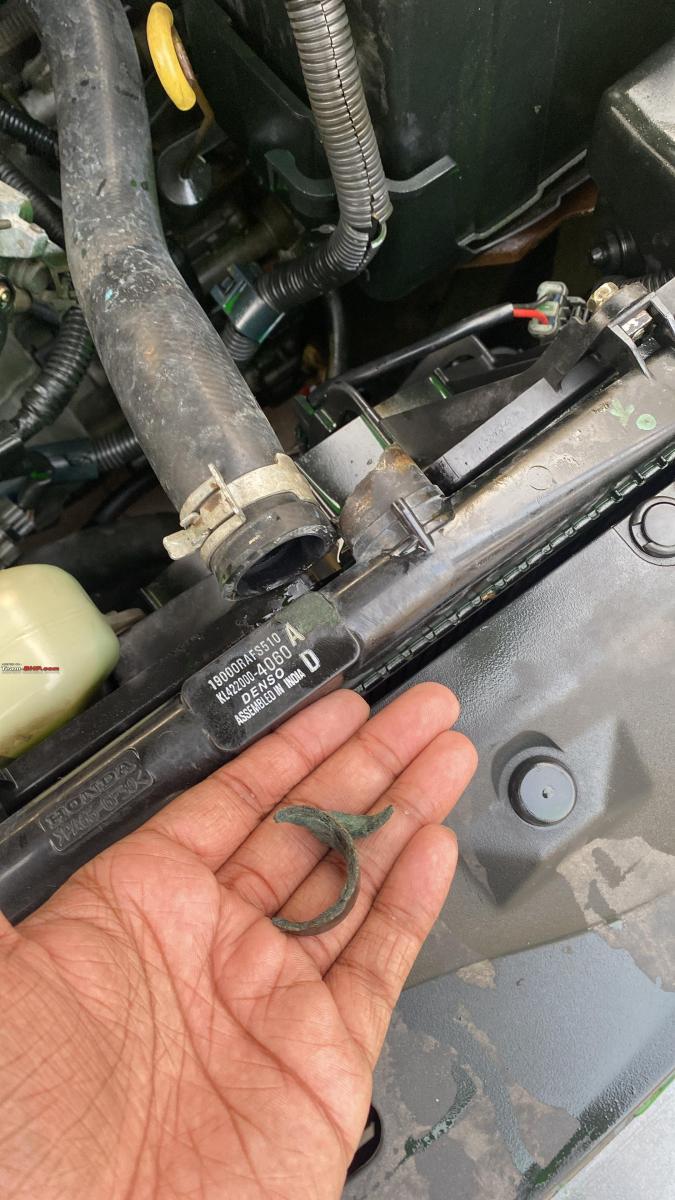
The radiator's neck had sheered off with the pressure. I have no idea why this could happen. I immediately had the car towed to my FNG. They had suggested a thermostat stuck open or a water pump failure.
Something to note, when I drive my car, the temperature gauge is never in the middle, it’s always been slightly cooler than the middle. Not sure if that’s relevant but yeah.
Any ideas/theories/personal experiences as to why this could’ve happened?
Here's what BHPian dhanushs had to say about the matter:
I initially would've thought overtightening of the hose clamp would've done it, but looking at the photo seems like that is not the reason.
If your radiator mount/engine mount is weak and the radiator to engine hose moves a lot, that will also induce a failure over time.
But looking at the bigger picture, the car is 21 years old. Think of it as a wear-and-tear failure.
Here's what BHPian NomadSK had to say about the matter:
I would be more interested to know what kind of fix was done to the hose. A new hose or the neck was just tightened to arrest the minor leakage. Rubber tends to lose its elastic properties over a period of time and if only tightening was done then that points to the mechanical damage to the radiator, in addition, due to the ageing of the vehicle the plastic component would have weakened over time.
Sorry, but I guess that doesn’t add up to the failure. Open Thermostat failure will run your engine cooler and the closed thermostat will not let the coolant circulate and will overheat the engine and you will get this warning on the dash. In both cases, nothing to do with the radiator assembly. And water pump failure would simply give you a first warning for engine overheating on your dash.
In my opinion, this is mechanical damage (a brittle failure) and has nothing to do with the temperature/pressure of the coolant. And if I match the clamp location, it almost matches to the location where the failure occurred. So it could be a weak plastic component, due to ageing, which got damaged during the clamping of the hose.
Here's what BHPian arjab had to say about the matter:
This looks to be a case of mechanical ageing. Can happen with any "teenage-d" automobile.
Don't lose sleep over it. Yes, a replacement radiator for an Accord will be pricey but you do not have any option but to change the whole radiator assembly. Avoid getting talked into "plastic welding" and "changing the top tank and sealing it" kind of stuff. In aluminium radiators, these "jugaad" fixes do not last long.
Also since your vehicle is a couple of decades old, if you haven't already, maybe it is a good idea to have certain main components checked for mechanical integrity & fitness.
Check out BHPian comments for more insights and information.
News
2000 km road trip in Honda Elevate: Comfort, fuel economy, ADAS & more
The fuel efficiency was around 15-16 km/l but the star of the show was the car's generous boot capacity.
BHPian akhilshenay recently shared this with other enthusiasts.
I recently completed a 2000 km trip from Trivandrum to Chennai and back in my Elevate, and I'd like to share my experience.
The journey was remarkably comfortable on both legs of the trip. The route to Chennai was congested, extending the travel time to 16 hours, especially with the added challenge of traveling with a toddler, necessitating frequent stops. The return trip, spanning 14 hours, was equally pleasant.
The Elevate proved to be exceptionally comfortable, surpassing my previous long-travel vehicle, the BRV, notably in its suspension. The seats were especially comfortable, but needed to purchase a neckrest in Chennai. However, I'm looking to upgrade to a higher-quality option that complements the tan interior without appearing out of place. Suggestions are welcome.
Despite the extended travel time and the challenges of a toddler on board, we experienced zero fatigue after the trip, a testament to the overall comfort of the Elevate.
Mileage received was around 15-16 kmpl for the whole trip which included a few hundred kilometers in Chennai city with heavy traffic. During my stay in Chennai, I installed a DDPAI mini dashcam by myself, driven by concerns over the chaotic traffic. While the dashcam provides crucial evidence, it struggles to capture number plates clearly under specific lighting conditions. Despite this limitation, I find overall satisfaction with the product.
The Honda Connect tracking feature demonstrated reliability in recording our travel routes. However, the displayed metrics proved to be less dependable, often showing instances of hard braking that didn't occur or failing to register when it did. Instant notifications for ignition start/stops, fuel warnings, and other alerts were consistently delivered. On the downside, the remote locking feature via the app exhibited sluggishness, with responsiveness depending on the mood of Honda servers, which occasionally failed to respond. The Alexa control feature, unfortunately, proved to be a disaster, never working successfully during my experience.
The braking performance of the Elevate stood out as extraordinary, consistently providing smooth stops even before reaching the intended mark.
The usual issue of Android Auto disconnecting was noted but occurred less frequently during this 2000 km journey. This may be attributed to keeping the cable consistently plugged in, mitigating the problem to some extent.
Other notable aspects include the impressive headlight throw, effectively illuminating the road. The speakers, satisfyingly good for my preferences, kept me engaged with enjoyable beats throughout the journey.
The star of the show, however, was the Elevate's generous boot capacity. Accommodating all the necessities and more, it stood out for its practicality and convenience.
Tried out all the ADAS features.
Lane Keep Assist: It's so good and makes driving effortless on highways. Even feeble lines are detected equally during both day and night.
Lane departure mitigation: This feature actually makes you a better driver. If you are changing lanes without using the indicators, the system will steer you back to the lane. So you will have the habit of using indicators even if you are about the overtake a scooter. If you decide to ignore the warning and continue, the system will let you do so without any issues.
Collision mitigation braking: If you are already a cautious driver, you might not encounter this system getting activated unless it was something you couldn't see. However, if it brakes, it will be quite harsh. A truck in front of me didn't notice the speed breaker barricade and braked at the last moment. I am a person who tries to brake as smoothly as possible even if it is an emergency. So I braked calmly and the vehicle was about to stop within safe distance. So I reduced the braking force to ease it out. Suddenly, the CMBS kicked it and it was quite harsh.
Auto high beam: It's a hit or miss. It doesn't seem reliable to me.
Adaptive cruise control: This is the most hated feature by me. The system's braking and acceleration are very aggressive. I have set 100 as my required speed, and if it detects a bike/ scooter on the side of the road, it brakes and reduces the speed quite early without even letting me drive pass safely. And after speed is reduced I changed the lane so there are no obstructions ahead. By that time, the speed might be 80, the system accelerates very hard with more than 4000 rpm. Since it's a new vehicle I haven't tried beyond 3000 rpm. So I stopped using ACC since it was not smooth.
Check out BHPian comments for more insights and information.
Pages



